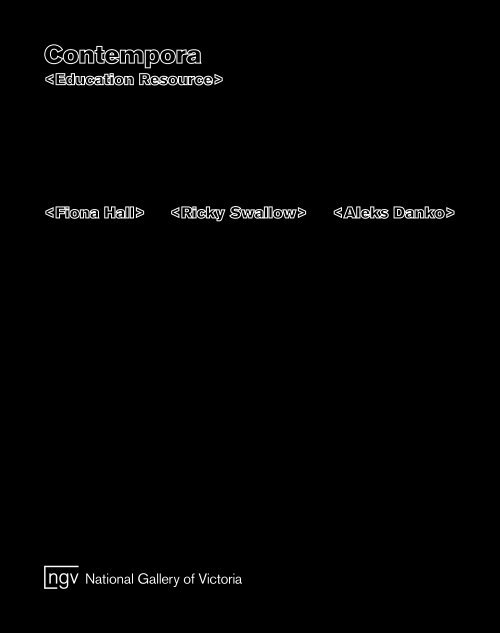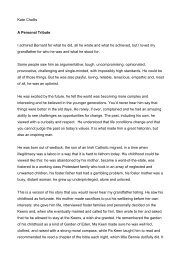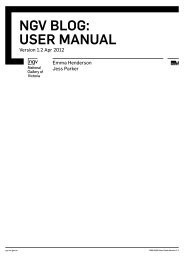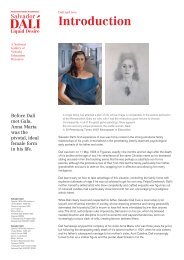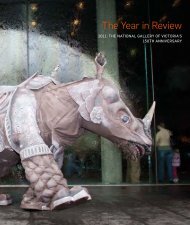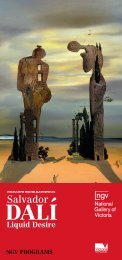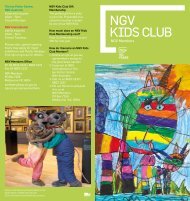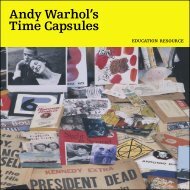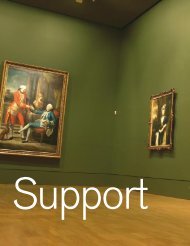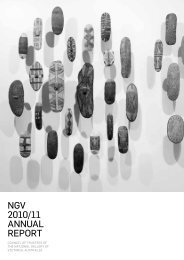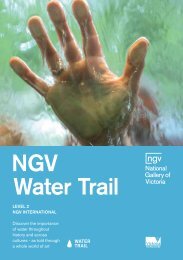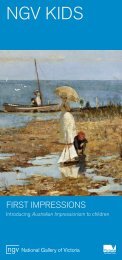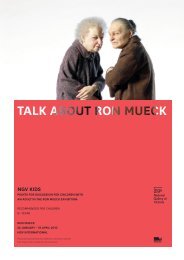Contempora (844.8 KB PDF) - National Gallery of Victoria
Contempora (844.8 KB PDF) - National Gallery of Victoria
Contempora (844.8 KB PDF) - National Gallery of Victoria
You also want an ePaper? Increase the reach of your titles
YUMPU automatically turns print PDFs into web optimized ePapers that Google loves.
In 1996 the <strong>Victoria</strong>n Governmentestablished the <strong>Contempora</strong>5program with the aim <strong>of</strong> fosteringand promoting contemporaryart practice in Australia. The<strong>Contempora</strong>5 exhibitions weredeveloped from an invitationalprize in which five participatingartists were selected and a winnernominated. In the first <strong>of</strong> theseexhibitions held in 1997, Fiona Hallreceived the award. The winner <strong>of</strong>the second <strong>Contempora</strong>5 awardin 1999 was Ricky Swallow. Thethird <strong>Contempora</strong> event – theinaugural <strong>Contempora</strong> Fellowship– incorporates the NGV’s strategicvision: to bring art and peopletogether. This vision establishesthe contexts through whichthe NGV works to broaden itsaudiences and outreach programs.The <strong>Contempora</strong> Fellowshipcomprises an intellectual residency<strong>of</strong> two years and a touringexhibition <strong>of</strong> new work producedby the Fellow during this time.In July 2002, <strong>Victoria</strong>n artist AleksDanko was announced as therecipient <strong>of</strong> the first <strong>Contempora</strong>Fellowship. Danko’s two-yearresidency with the NGV culminatesin the exhibition SONGS OFAUSTRALIA VOLUME 16 –SHHH, GO BACK TO SLEEP (anun–Australian dob-in mix) whichbuilds on his Songs <strong>of</strong> Australiaseries. The exhibition openedat The Ian Potter Centre:NGV Australia and tours toBendigo Art <strong>Gallery</strong> and SwanHill Regional Art <strong>Gallery</strong>.This resource gives a briefbackground to the two former<strong>Contempora</strong> winners Fiona Halland Ricky Swallow and pr<strong>of</strong>iles thecurrent <strong>Contempora</strong> Fellow AleksDanko. It also raises issues andtopics for discussion which arerelevant to studies <strong>of</strong> Art, Englishand Politics and to dialoguesconcerning the nature <strong>of</strong> artcompetitions.IMAGES L-RFiona Hallborn Australia 1953Dead in the water1999 (detail)polyvinyl chloride, glass beads,silver wire, glass, wood andtransparent syntheticpolymer resin106.2 x 129.1 x 129.2 cm(installation)Purchased, 1999.<strong>National</strong> <strong>Gallery</strong> <strong>of</strong> <strong>Victoria</strong>© Courtesy <strong>of</strong> the artistRicky Swallowborn Australia 1974Model for a sunken monument1999 (detail)synthetic polymer paint oncomposition board108.2 x 222.0 x 242.2 cm(overall)Purchased through The ArtFoundation <strong>of</strong> <strong>Victoria</strong> withthe assistance <strong>of</strong> the JoanClemenger Endowment,Governor, 1999.<strong>National</strong> <strong>Gallery</strong> <strong>of</strong> <strong>Victoria</strong>© Courtesy <strong>of</strong> the artist andDarren Knight <strong>Gallery</strong>, Sydney.Aleks Dankoborn Australia 1954SONGS OF AUSTRALIAVOLUME 16: SHHH,GO BACK TO SLEEP(an un-Australian dob-in mix)2003 (detail)ink and pencil on paper, stainedplywood, sound recording,lighting, acrylic, vinyl(installation, dimensions variable)
Fiona Hall makes works whichare enticing, desirable andprovocative, encouraging theviewer to unravel layers <strong>of</strong> beauty,wit, political innuendo and seriousagendas. She was born in Sydneyin 1953 and studied painting atthe <strong>National</strong> Art School in Sydneybetween 1972 and 1975. In 1982,she was awarded a Master <strong>of</strong> FineArts Photography from the VisualStudies Workshop in Rochester,New York. During her careerHall has worked as a practisingartist and lecturer, and for shortperiods as an Artist in Residenceat the Tasmanian School <strong>of</strong> Artin 1981 and the Phillip Institute<strong>of</strong> Technology, Preston, <strong>Victoria</strong>in 1990. Hall has had numerousindividual exhibitions and her workhas been included in significantgroup exhibitions both in Australiaand overseas. Her work is widelyrepresented in major state andregional galleries across Australia.Fiona Hall believes that winningthe inaugural <strong>Contempora</strong>5art prize in 1997 with her workGive a dog a bone provided herwith the impetus to abandon thefinancial security <strong>of</strong> her teachingposition and take <strong>of</strong>f on her ownas a full-time artist. Whilst sherealised this was a gamble due tothe unpredictable nature <strong>of</strong> salesin the art world, she has sinceappreciated the freedom bothto focus exclusively on her artpractice and to travel.Hall concedes that the difficultaspect <strong>of</strong> competitions for an artistis that they involve putting one’sego on the line, but she entersthem if they have the potential tomake a difference to what shecan achieve as an artist. She isrealistic about art competitions,emphasising the elements <strong>of</strong>luck and the subjective nature<strong>of</strong> judging, whilst acknowledgingthat what’s great today mightnot be considered so greatin 50 years’ time.Hall, like many creative people, hasa wide spectrum <strong>of</strong> interests whichinform her work. The influences onher art practice have changed asher life has unfolded and revealedthe world as more complex thanshe had imagined. Literature andaspects <strong>of</strong> science were keyinfluences in her early career andshe has an endless fascination fornatural history, particularly botany.Ideas reflecting various forms <strong>of</strong>friction in the world, and social andenvironmental politics, now play anincreasingly important role.Hall possesses extraordinary artmaking skills and has masteredmultiple practices includingphotography, beading, installation,painting, collage and ceramics.Unlike some other contemporaryartists including Aleks Danko, whocollaborate with specialists, shemakes all <strong>of</strong> her own works. Thisallows her to make spontaneousdecisions as the project evolvesfrom her initial idea and chosenmaterial. An exception to this was
her design for The fern garden,1998, at the <strong>National</strong> <strong>Gallery</strong> <strong>of</strong>Australia, which involved workingwith expert engineers and ablacksmith, an experience sheenjoyed immensely. Apart from thisfreedom to alter the work duringproduction, Hall finds it intenselysatisfying to become totallypr<strong>of</strong>icient in a skill before movingon to the next project.A defining element <strong>of</strong> Hall’s workis her imaginative transformation<strong>of</strong> everyday, <strong>of</strong>ten dispensableobjects, such as sardine cans,bank notes and video tapes, intometaphors for agendas in life,whereby the material and theconceptual aspect <strong>of</strong> the workare melded. Whilst these materialobjects <strong>of</strong>ten metamorphose intoitems <strong>of</strong> exquisite beauty, theyremain utilitarian and yet transcendtheir function by becomingsignifiers, <strong>of</strong>fering different ways <strong>of</strong>looking at the world.Hall feels fortunate that her workis shown at the <strong>National</strong> <strong>Gallery</strong> <strong>of</strong><strong>Victoria</strong> and the <strong>National</strong> <strong>Gallery</strong><strong>of</strong> Australia, but tries hard to bringher work to a wider audiencethrough a diverse range <strong>of</strong> outlets.She believes that displaying herwork in contexts outside the artgallery is desirable – a naturalhistory museum or supermarket,for example, could be interestingvenues providing they madeappropriate connectionswith the work.Hall argues that althoughcontemporary art can’t changethe face <strong>of</strong> the planet enormously,it should be challenging andencourage the viewer to thinkabout issues they haven’tconsidered before, sometimesresulting in a change <strong>of</strong> attitude.TEXTSusie May in discussionwith Fiona HallIMAGESMiwulngini (Ngan’gikurunggurr) /Nelumbo nucifera / lotusaluminium & tin24.6 x 12.1 x 3.6 cmVuyu wiri (Adna-mat-na) /Craspedia uniflora /billy’s buttonsaluminium & tin24.5 x 14.8 x 5.0 cmWuuloitch (Tjapwurong) /Themeda australis /kangaroo grassaluminium & tin24.8 x 16.1 x 4.2 cmfrom the seriesParadisus Terrestris Entitled1996Purchased through The ArtFoundation <strong>of</strong> <strong>Victoria</strong> with theassistance <strong>of</strong> the Rudy KomonFund, Governor, 1997.<strong>National</strong> <strong>Gallery</strong> <strong>of</strong> <strong>Victoria</strong>© Courtesy <strong>of</strong> the artistDead in the water1999polyvinyl chloride, glass beads,silver wire, glass, wood andtransparent synthetic polymerresin106.2 x 129.1 x 129.2 cm(installation)Purchased, 1999.<strong>National</strong> <strong>Gallery</strong> <strong>of</strong> <strong>Victoria</strong>© Courtesy <strong>of</strong> the artist
Ricky Swallow’s finely craftedmodels blend images <strong>of</strong> popularculture, fantasy and scientificwonder, trapped in time andcaught in a quiet stillness. Amelting mask <strong>of</strong> Darth Vaderfrozen in motion, an isolated anderoded miniature monument <strong>of</strong> SirRoy Ground’s <strong>National</strong> <strong>Gallery</strong> <strong>of</strong><strong>Victoria</strong>, and tables spread withspecimens <strong>of</strong> manufactured marinelife, all have a place in Swallow’ssurreal world.Ricky Swallow was born in 1974in San Remo, <strong>Victoria</strong>. As a child,he recalls frequently drawing andmaking things. This led him toMelbourne to undertake tertiarystudies in drawing at the <strong>Victoria</strong>nCollege <strong>of</strong> the Arts (VCA) between1994 and 1997. He was the 1999recipient <strong>of</strong> the <strong>Contempora</strong>5award, and now lives and works inLos Angeles.Swallow maintains that his trainingin drawing at the VCA has hadlittle influence on his sculpturalwork. Instead, his drawingpractice remains separate fromhis sculptural work. For Swallow,drawing provides a place <strong>of</strong>escape at the completion <strong>of</strong> asculpture, or a way to capturethings <strong>of</strong> interest whilst travellingand visiting museums.Swallow’s replicas <strong>of</strong> everydayobjects use a variety <strong>of</strong> mediaincluding cardboard, resins,plumbing pipes and rubber. Greattechnical skill, craftsmanshipand lengthy periods <strong>of</strong> timeare required for his art-makingprocess. Swallow believes it isimportant to craft his own work,rather than allowing technicians toproduce his ideas. He considersthat the process <strong>of</strong> crafting orreplicating something requires aresponsibility to continually retreator re-consider original formsagain and again. Swallow assertsthat making is a way to remainoccupied, to mark timeand maintain a sense <strong>of</strong> artistrybehind the works.Swallow is fascinated by the wayin which museums and galleriespresent knowledge. In preparinghis own work for exhibition, thecontext in which it is displayedis carefully considered. Therelationship between his workand the exhibition space aidsinterpretation and contributes tothe mood. His latest exhibitionKilling time, at Darren Knight<strong>Gallery</strong> in Sydney (24 February– 20 March 2004), presents astill-life carving <strong>of</strong> all the fish andmarine creatures he has caught.It has been presented in isolation,spot lit against salon-style paintedwalls like a museum setting. Hehas designed this setting to allowthe viewer the kind <strong>of</strong> meditationthe piece commands.
Winning the <strong>Contempora</strong>5 prizehas had positive and negativeoutcomes for Swallow. It hasallowed him to travel and continuemaking ambitious works withoutthe financial pressure <strong>of</strong> having todo other jobs. However, he findsthat his high pr<strong>of</strong>ile and reputationas a significant Australiancontemporary artist can at timesbe frustratingly indelible.TEXTHeather Whitelyin discussion with Ricky SwallowIMAGEKilling time2003–2004Laminated jelutong, maple108 x 184 x 118 cm (irregular)© Courtesy <strong>of</strong> the artist andDarren Knight <strong>Gallery</strong>, SydneySwallow believes that the idea <strong>of</strong>prizes and competitions seemsa little foreign to the art industry;however he suggests that artistsare secretly quite competitive.He argues that art prizes andcompetitions are important asthey create a form <strong>of</strong> hype thatbrings art to the general public.This promotes awareness andencourages opportunities forsociety to engage with the issuesand concerns <strong>of</strong> contemporarylife, reflected in the practice <strong>of</strong> theartists <strong>of</strong> our time.
Aleks Danko was born in Adelaidein 1950 and studied at the SouthAustralian School <strong>of</strong> Art between1967 and 1970. Since then he hashad 35 solo exhibitions and beenincluded in numerous exhibitions inAustralia and overseas. His work isrepresented in all major state andregional galleries in Australia.When approaching Aleks Danko’slatest installation SONGS OFAUSTRALIA VOLUME 16 –SHHH, GO BACK TO SLEEP (anun-Australian dob-in mix), 2004,we are immediately confrontedby a range <strong>of</strong> challenging sightsand sounds. As we enter aprotected inner courtyard, we finda black constructed house withsix windows on each side, sittingcomfortably between four highwalls. The walls are covered withmore than a hundred paintings<strong>of</strong> small red houses, with handpaintedslogan-like texts on each.The paintings resemble a crossbetween newspaper headlines andpolitical posters. From inside theblack house, light flashes on and<strong>of</strong>f and the pre-recorded voice <strong>of</strong>Australia’s voiceover ‘king’ RobbieMcGregor reads each visual text ina smooth, comforting voice.SONGS OF AUSTRALIAVOLUME 16 is the culmination<strong>of</strong> a cycle <strong>of</strong> work completed byAleks Danko between 1996 and2004, and is also the culmination<strong>of</strong> his two-year <strong>Contempora</strong>Fellowship at the <strong>National</strong><strong>Gallery</strong> <strong>of</strong> <strong>Victoria</strong>. The work isunashamedly political and, likethe Volumes which preceded it,draws our attention to some <strong>of</strong>the most important political, socialand cultural issues <strong>of</strong> our times,including immigration, terrorism,reconciliation and environmentalconcerns. Each issue is presentedthrough a variety <strong>of</strong> everydaysymbols (the suburban house inparticular) and with a healthy dose<strong>of</strong> irony, wit, satire and pun.Danko’s previous work in thisseries has included installations,site-specific projects, live artinterventions, public commissionsand collaborative art. The presentexhibit embodies the disciplines<strong>of</strong> sculpture, architecture,painting, drawing and theatre.Danko is involved in the designand construction <strong>of</strong> all <strong>of</strong> theseaspects and yet respects thegreater technical knowledge <strong>of</strong>certain experts needed to finalisethe project, such as carpenters,electricians and curators. Heenjoys the politics <strong>of</strong> collaborativework, and was thus a perfectchoice for the <strong>Contempora</strong>Fellowship, which requires aworking dialogue to exist betweenthe artist and other <strong>Gallery</strong> experts.
Danko believes that the present<strong>Contempora</strong> Fellowship is moredemocratic than the former system<strong>of</strong> one cash prize, and is alsomore productive for all partiesconcerned. Ideally he would like tosee a system <strong>of</strong> art awards whichgive artists a choice <strong>of</strong> engagingin a variety <strong>of</strong> work-relatedplacements like industrial settingsand university faculties.Installation art became popular inthe early 1970s in Australia withthe influence <strong>of</strong> such Americanartists as Jim Dine and ClaesOldenburg and via the spirit <strong>of</strong>Kurt Schwitters (a greatmanipulator <strong>of</strong> texts), MarcelDuchamp and the Dadaists <strong>of</strong>the Cabaret Voltaire. Danko talks<strong>of</strong> being inspired by these artistsin particular, and by a similaranarchistic trend in British comedywhich included such televisionshows as The Frost Report andMonty Python’s Flying Circus.Finally, it is important to rememberthat Danko was born <strong>of</strong> migrantparents who came to Australia asrefugees from war-torn Europein 1948. In many ways he grewup in two cultures from the verybeginning <strong>of</strong> his life. References tohis childhood in suburban Adelaideare found in much <strong>of</strong> his work,reflecting some <strong>of</strong> the similaritiesand differences between thesocial and political landscape<strong>of</strong> Australia then and now. Hisbackground could also be seenas a major reason for his ongoingcommitment to a questioning form<strong>of</strong> political art.TEXTGraham Parkerin discussion with Aleks DankoIMAGESONGS OF AUSTRALIAVOLUME 16: SHHH,GO BACK TO SLEEP(an un-Australian dob-in mix)2003ink and pencil on paper, stainedplywood, sound recording,lighting, acrylic, vinylinstallation, dimensions variable
The recent works <strong>of</strong> Danko,Hall and Swallow are inspiredby social, political and culturalissues <strong>of</strong> our time. Discuss howart can be a potent medium forexpressing these issues.Do you think the works <strong>of</strong> these<strong>Contempora</strong> artists are onlyrelevant to Australian society in alocal context, or do they addressinternational concerns?What are the advantages <strong>of</strong>artists presenting their ideasthrough a broad range <strong>of</strong> mediaand techniques?Do you think all aspects <strong>of</strong> theart-making process shouldbe carried out by the artist,or is it acceptable for themto collaborate with experttechnicians?How have artists in the pastcollaborated with others tocomplete their works?In what ways can artcompetitions benefit both theartist and the viewing public?Discuss the possible negativeaspects <strong>of</strong> art competitions.Choose a work by one <strong>of</strong> the<strong>Contempora</strong> artists. Visuallyanalyse the work from one<strong>of</strong> the following interpretiveframeworks:• Culture• Gender• Historical context• Politics• Postmodernism• Psychoanalysis• SymbolismACKNOWLEDGMENTSThis education resource hasbeen prepared by GrahamParker, Susie May, MichaelNichols and Heather Whitely,Education Officers, with theassistance <strong>of</strong> Paula Lindley,Senior Education Officer,<strong>National</strong> <strong>Gallery</strong> <strong>of</strong> <strong>Victoria</strong>.Special thanks to Aleks Danko,Fiona Hall and Ricky Swallow fortheir contribution, and toDarren Knight <strong>Gallery</strong> fortheir helpful assistance.DESIGNNGV Graphic DesignPHOTOGRAPHYNGV Photographic Services(except Killing time)


